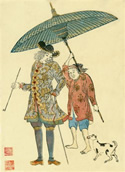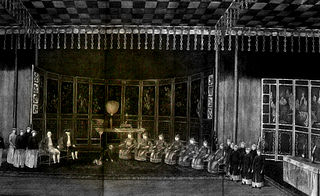Isaac Titsingh
Dutch diplomat (1745 - 1812) From Wikipedia, the free encyclopedia
Remove ads
Isaac Titsingh FRS (10 January 1745 in Amsterdam – 2 February 1812 in Paris) was a Dutch surgeon, scholar, merchant-trader and ambassador.[1]

Japan, 1779-1784

At Dejima Island in Japan, Titsingh was the head of the Dutch East India Company(Vereenigde Oost-Indische Compagnie or "VOC" in Dutch) during 1779-1780, 1781–1783, and 1784. In these years, the Japanese policy of seclusion of isolation (sakoku) limited all contact with non-Japanese.[2] In this highly controlled context, the VOC traders became the sole official conduit for trade and for scientific-cultural exchanges between Japan and the West.
Titsingh is believed to have been the first Freemason in Japan.[3]
Remove ads
India, 1785-1792
In 1785, Titsingh was appointed Director of the VOC trading post at Chinsura in Bengal. He formed a friendship with William Jones, the philologist and Bengal jurist.[4]
Batavia, 1792-1793
Titsingh’s return to Batavia (now Jakarta, Indonesia) led to new VOC positions as Ontvanger-Generaal (Treasurer) and later as Commissaris ter Zee (Maritime Commissioner).
In Batavia, Titsingh met with the British Ambassador do China, Lord Macartney who was travelling to the Imperial Court in Peking. Titsingh encouraged McCartney to give up on a planned expedition to Japan in 1793.[5]
China, 1794-1795

Titsingh was appointed Dutch Ambassador to the court of the Emperor of China. He was in Peking for the celebrations of the sixtieth anniversary of the reign of the Qianlong Emperor. In Peking, the Titsingh delegation included Andreas Everardus van Braam Houckgeest[6] and Chrétien-Louis-Joseph de Guignes.[7]
Titsingh is believed to have been the first Freemason in China.[8] and the only to be received personally in the court of the Qianlong emperor.
Remove ads
Return to Europe, 1796-1812
Among the Japanese books brought to Europe by Titsingh, was a copy of Sangoku Tsūran Zusetsu (三国通覧図説, An Illustrated Description of Three Countries) by Hayashi Shihei (1738–93). This book, which was published in Japan in 1785, deals with Chosen (Korea) and the kingdom of Ryukyu (Okinawa) and Ezo (Hokkaido).[9] In Paris, the text represented the first appearance of Korean han'gŭl in Europe.[10]
After his death

Titsingh died in Paris (February 2, 1812), and he is buried in Père-Lachaise cemetery.[11]
After Titsingh's death, the printed original and Titsingh's translation were purchased by Jean-Pierre Abel-Rémusat (1788–1832) at the Collège de France.[12]
In 1832, Julius Klaproth (1783-1735) at the Institut Royal publish his edited version of Titsingh's translation.[13]
Remove ads
Selected works
In a statistical overview derived from writings by and about Seki Takakau, OCLC/WorldCat includes roughly 90+ works in 150+ publications in 7 languages and 1,600+ library holdings.[14]
- "Bereiding van saké en soya," in Verhandelingen van het Bataviaasch genootschap van Kunsten en Wetenschappen (1781)[15]
- Cérémonies usitées au Japon pour les mariages et les funérailles (1819).[1]
- Mémoires et anecdotes sur la dynastie régnante des djogouns, souverains du Japon (1820),[1]
- Illustrations of Japan (1822)[15]
- Bijzonderheden over Japan (1824)[15]
- Annales des empereurs du Japon (1834)[15]
Remove ads
Related pages
References
Other websites
Wikiwand - on
Seamless Wikipedia browsing. On steroids.
Remove ads
